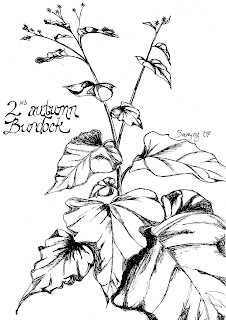We were born, born to be wild." -Steppenwolf
Some plants bore cultivation like a cross, domesticity like a burden. When their captors attentions and fancies turned to more trendy foods and flowers, some, like Lamb's Quarters, jumped the garden fence and took off for parts unknown. Wild at heart, Lamb's Quarters set its gaze on the horizon and never looked back.
A hardy weed with cunning survival strategies, it naturalized it's way across the globe to pop up year after year in my old potato patch, thousands of miles from it's European origins.
When fully grown, this adventurous, sprawling annual can be 3 feet tall. However the leaves are best when the young plant is just a few inches high. The diamond or arrow shaped leaves shimmer with a green/blue velveteen that feels like fine dust. When very young the leaves may have only one or two teeth near the base, but, like us, grow more teeth as they age.
Consume these leaves raw or boiled. Lamb's Quarters, like plantain and violet, was a precursor to domestic spinach and can be a modern "substitute". Lamb's Quarters provides more Vitamin A and C than spinach, however it also contains a similar quantity of a calcium absorption inhibitor: oxalates (Eating Wild Plants by Kim Williams). Which means moderation and separation from your calcium supplement.
Poultices of bruised leaves have been used on burns, wounds, inflamed eyes, headaches, and heat stroke victims. Additionally, a chewing of leaves is a reputed tooth ache reliever.
A tea of this plant has been recommended for stomach aches and joint pains.
Later in the summer tiny gray-green flowers will pop up like a blight on the branch ends. These are also edible, good for salads or, apparently, as cold cereal with milk!(Edible and Medicinal Plants of the
These inconspicuous flowers give way to an astonishing 50,000 to 70,000 black poppy-esc seeds, which could be roasted and ground for coffee or flour, or whole in muffins or porridge.
Evidently, Napoleon relied heavily on these for making a black bread for his troops (Plants of the Southern Interior by Lone Pine). I can see him now: in thin woods, apron tied in a bow, cookbook lays open, one hand kneads dough, the other tucks securely into his shirt, the edges of a checkered tabled cloth flutters in the breeze, a bird chirps above him and a sense of domestic tranquility rests on his face, while the sounds of raging battle clang up from the valley below. The angry army fueled by his coal colored biscuits. I wonder if he then, gently placed poultices of Lamb's Quarters upon the wounds of his men. Perhaps he first washed their wounds with Lamb's Quarters roots, a soap substitute. (Kershaw).
Similar to the plant and perhaps even Napoleon himself, local native Americans also made use of what fate and nature provided them. Not being native-plant-purists, the Stl'atl'imx, Okanogan, Secwepemc, Flathead and
The name Lamb's Quarters caught the attention of this mostly vegetarian writer, not only because it conjured images of slain baby sheep but also because the name causes subject/verb agreement issues. "Lamb's Quarters" is perhaps based on some sort of harvest festival, or confusion with another plant. The scientific Chenopodium album is the only name with any sense, meaning goose foot, as the leaves appear to be shaped like goose feet (Lone Pine). This is even less appetizing than Lamb's Quarters.
Think of the adventures this humble weed has been on! Ancient harvest festivals, war with Napoleon, unwelcome "transitions" with the
God grant us such hardy versatility on our own journeys. When I eat these wild things, I hope to inherit their will to thrive in whatever rocky or lush soils fate should plant me.




















